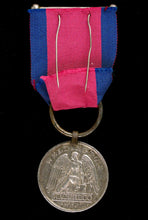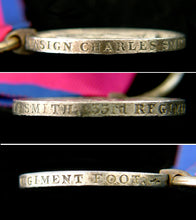Waterloo Medal, 1815 (Ensign Charles Smith, 33rd Regiment of Foot) fitted with steel clip and ring suspension
Adding product to your cart
Medal 36mm x 36mm
Condition: Light contact marks and edge bruising, otherwise better than very fine.
Ensign Charles Smith was born circa 1793 and first served as a Second Lieutenant in the Royal Marines, receiving his commission on 29 September 1808, and going to sea in the38-gun frigate H.M.S. Rota (Captain Philip Somerville, R.N.). In 1809 Rota was part of the ill-fated Walcheren Expedition which sailed from the Downs with the aim of demolishing the dock-yards and arsenals at Antwerp, Terneuse and Flushing. On 11 August, Rota was part of Captain Lord William Stuart’s squadron that came under fire when sounding the Baerlandt channel for advance of the fleet.
Read more
After three years and some months Smith resigned his commission in the Royal Marines to purchase an Ensigncy in the Line. He became Ensign in the 33rd on 24 June 1813, the regiment having returned to Europe from India in 1812 after sixteen years in the sub-continent that included distinguished service under Wellington, as the Hon Arthur Wellesley, in the Fourth Mysore War.
In November 1813, the 33rd sailed for Holland to take part in the campaign against Bergen-op-zoom, after which it remained at Antwerp until March 1815 when news of Napoleon’s escape from Elba was received. The 33rd was assigned to the 5th British Brigade under the command of Sir Colin Halkett, the brigade in turn forming part of Sir Charles Alten’s 3rd Division. The battalion came into action towards the end of the Battle of Quatre Bras on 16 June, but still managed to suffer three officers and sixteen men killed, and seven officers and 70 men wounded, and ten missing. On the day of Waterloo, the 33rd, brigaded with 2/30th, 2/73rd and 2/69th Foot, held a position to the right centre of the Allied army on rising ground close to La Haye Sainte, being repeatedly harassed by French artillery fire and cavalry attacks. At the advance of Maitland’s Guards Brigade on Wellington’s direct order at the close of the day, Halkett pushed the 33rd and 2/69th forward to cover their left, but suddenly the grenadiers of the Middle Guard confronted them. A volley stopped the French for a moment but their accompanying horse artillery began firing into the British line which Halkett ordered back to the crest, but they became intermingled during the withdrawal and disorganised when Halkett was wounded. Fortunately Major Kelly of Wellington’s staff restored order in the two regiments as the Middle Guard continued towards the crest where the 33rd and 2/69th bettered them in a fire fight before a Dutch horse artillery battery added to the Frenchmen’s discomfort by firing into their right flank, causing them to break and run.
Total casualties for the 33rd were two officers and 33 men killed and eight officers and 92 men wounded. On 8 July the 33rd entered Paris as part of the army of occupation. While there Ensign Smith was advanced to Lieutenant without purchase on 14 August. On 23 December 1815 the battalion returned to England. Smith was placed on half-pay on the reduction of the Army in 1817 and subsequently resided in Germany.
Ex: Glendining, 1908
DNW, 2004








